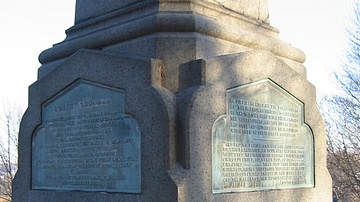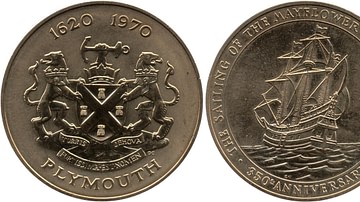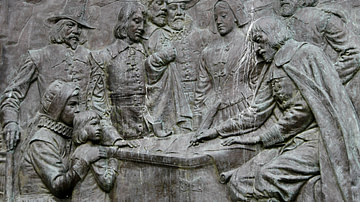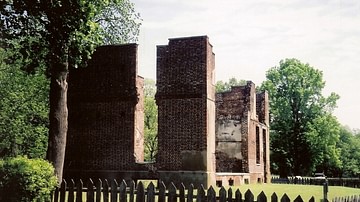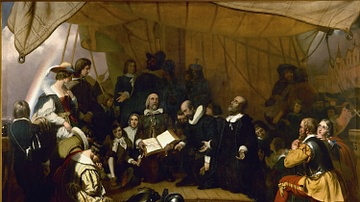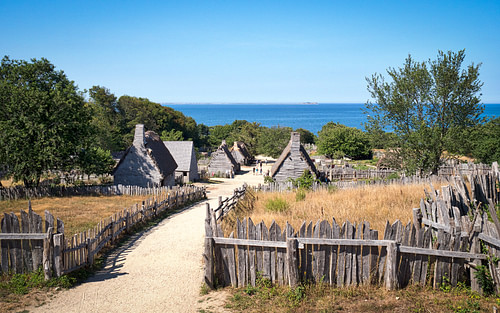
The Plymouth Colony (1620-1691) was the first English settlement in the region of modern-day New England in the United States, settled by the religious Separatists known as the “pilgrims” who crossed the Atlantic Ocean on the Mayflower in 1620, fleeing religious persecution, to establish a settlement where they could worship freely in the New World.
They had planned to come ashore near the English colony of Jamestown, Virginia (founded in 1607 and a thriving settlement by 1620) or in the Hudson Valley region of present-day New York State controlled by the Dutch since 1609. Bad weather had blown them off course, however, and their dwindling supplies, coupled with poor weather conditions, forced them to put ashore in modern-day Massachusetts where they would settle and, with the help of the Native Americans of the region, survive to establish their colony.
The area was already known to European traders, investors, and mariners as the earlier Popham Colony had been founded there (north of where the pilgrim's landed, in present-day Bath, Maine) in 1607 which had only survived 14 months. It was visited by Captain John Smith (l. 1580-1631), the leader of the Jamestown settlement, in 1614 who mapped and charted it but none of Smith's work or the reports about Popham could have prepared the pilgrims for the experience of the harsh New England winter of 1620-1621 during which over half of them died.
The survivors were sustained and enabled to continue their vision of a New Jerusalem of religious freedom by the indigenous people who taught them how to plant corn, beans, and squash – the so-called “three sisters” – and how to live in the New World. According to the traditional account, the grateful settlers shared an autumn feast with the natives which, in the 19th century, was honored with the establishment of Thanksgiving Day on the last Thursday of November in the United States.
Relations between the settlers and their early benefactors would sour, however, as more and more land was taken for permanent settlements, especially after the establishment of the Massachusetts Bay Colony in 1628/1630, resulting in King Phillip's War of 1675-1678. These conflicts, as well as the diseases brought by the Europeans between 1607-1620, severely reduced the population of the Native American tribes of the region, allowing for easier settlement by the influx of Europeans who followed those of the first settlement.
The Plymouth Colony would continue until 1691 when was joined to the Massachusetts Bay Colony. In the modern era, the original site of the landing of the Mayflower at Plymouth Rock, whether historically accurate or not, is regarded as a kind of national shrine in United States' history, and the story of the Plymouth Colony has become a foundational myth.
Beliefs & Voyage
The pilgrims left their homes for the New World because their religious beliefs clashed with those of the Church of England, which was led by King James I of England (r. 1603-1625) who had the power to arrest, imprison, and execute those he felt were spreading seditious ideologies. The ideology in this case was Brownism, named after its chief spokesman Robert Browne (l. 1550-1633), a former Anglican priest who embraced a fundamentalist, literal, interpretation of the Bible and rejected the Anglican church's teachings and practice.
Browne's beliefs were adopted by John Robinson (l. 1576-1625), who formed a congregation of religious separatists which included later notables such as John Carver (l. 1584-1621), William Bradford (l. 1590-1657), and Edward Winslow (l. 1595-1655) and, after a number of their people were arrested in 1607, fled England for Leiden, the Netherlands, where a number of other separatists had already gone as the government practiced religious tolerance. After establishing themselves, however, one of their members, William Brewster (l. 1568-1644), published a tract criticizing King James I and the Anglican church in 1618, which brought the civil authorities to arrest him. He was hidden by the congregation, but they understood they needed to leave and decided to travel as far as they could from James I's reach to the New World.
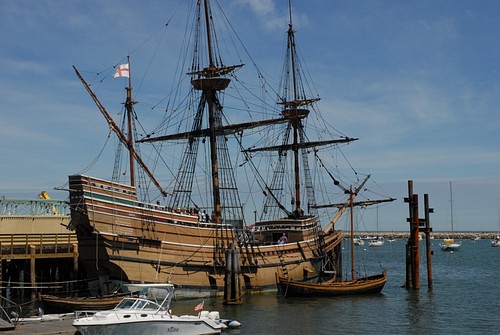
Middlemen known as merchant-adventurers served to pair investors with expeditions, and one of these was Thomas Weston (l. 1584 - c. 1647) who, negotiating with two members of the congregation, Robert Cushman (l. 1577-1625) and John Carver, created a joint-stock venture for investors through the Virginia Company of London and received a patent for the pilgrim's expedition. A friend or member of the congregation, one Captain Blossom, purchased them a passenger ship, the Speedwell, and Weston rented the services of a larger cargo ship, the Mayflower, and its crew.
The pilgrims left on their voyage in the two ships in July of 1620, but the Speedwell leaked repeatedly, necessitating delays while it was repaired. It was finally abandoned and 20 of its passengers taken aboard the Mayflower, which set sail on 6 September 1620. The ship was not designed to transport passengers and so the 100 pilgrims lived in cramped quarters on the middle gun deck, in dim light and with no privacy, for the two-month crossing of the Atlantic.
They had been granted a charter in the name of the Virginia Company and were supposed to land above the already established colony of Jamestown and below the Dutch colonies of the Hudson River Valley. The seas were rough, however, and they were blown off course, finally sighting land far north of their intended goal in the region of modern-day Massachusetts. Lack of supplies and more bad weather forced their decision to abandon going further and they dropped anchor on 11 November 1620.
Mayflower Compact & First Winter
Jamestown or the Dutch colonies were already under the rule of European law but the land they had reached, they instantly understood, was not. Among the passengers were some the pilgrims referred to as Strangers (those not of the faith) and, according to the account written by William Bradford, once it was decided they would settle where they had landed, some of these men made it clear they would live however they wanted since no law could constrain them. It was decided, therefore, that before anyone left the ship, a contract would be drawn up binding everyone to laws that served the common good. Bradford writes:
This was occasioned partly by the discontented and mutinous speeches that some of the strangers amongst them had let fall: that when they got ashore, they would use their liberty that none had power to command them, the patent procured being for Virginia, and not for New England. (49)
The Mayflower Compact was an agreement that all laws passed by the vote of a general assembly would be observed for the common good and that everyone signing the agreement would abide by it. Forty-one of the male passengers signed, and only after that was anyone allowed to leave the ship.
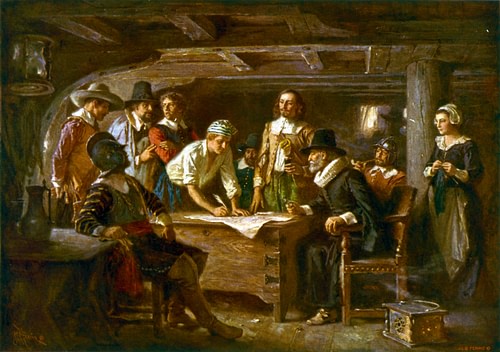
Most of the passengers remained on the Mayflower that first winter where disease spread rapidly while those on shore, who were trying to build shelters, suffered from the cold. Over 50% of the passengers and crew died during the winter and those who survived owed their lives to a few (Bradford numbers around seven) who managed to stay healthy and nurse the rest.
First Year & Daily Life
The colonists were ultimately saved, however, by the intervention of the Native Americans Tisquantum (better known as Squanto, l. c. 1585-1622) of the Patuxet tribe and Samoset (also given as Somerset, l. c. 1590-1653) of the Abenaki. Samoset approached the pilgrims first in broken English and introduced them to Squanto, who had been kidnapped in 1614 by the Englishman Thomas Hunt, along with many others, to be sold into slavery in the West Indies. Squanto had escaped, made his way to England, learned the language, and returned.
These two then introduced the pilgrims to Ousamequin (also known by his title Massasoit Sachem, l. c. 1581-1661), chief of the Wampanoag Confederacy, who would become the pilgrims' ally. European diseases spread by earlier European expeditions had greatly reduced Massasoit's people, and though still a great chief, he was hoping for an alliance with the Plymouth Colony against his stronger and more numerous rivals. John Carver, Edward Winslow, and Massasoit came to an agreement that would be mutually beneficial.
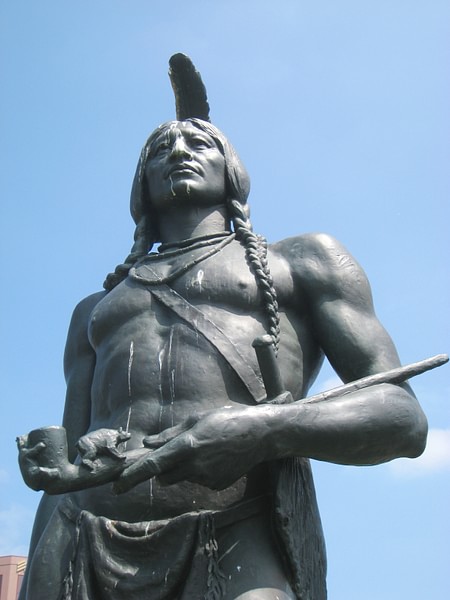
The agreement they had made with Weston stipulated a certain amount of goods to be delivered to investors but, so far, the pilgrims had nothing of value to send. Ships arrived, carrying more colonists (some of them members of the Leiden community) and letters from Weston to Carver demanding payment. With the help of Squanto, the pilgrims were able to establish trade relations with Massasoit and other tribes not of the Wampanoag Confederacy for furs, which helped pay down, though not eliminate, their debt to Weston.
The Plymouth Colony's daily life was centered on the Bible which was interpreted literally as the inerrant Word of God. Accordingly, although women were understood as being of equal value in the eyes of God, they were inherently more sinful and weaker than men since the story of the Fall of Man in the Book of Genesis made it clear that Eve was disobedient to God's commandment regarding the Tree of the Knowledge of Good and Evil and Adam was only deceived by Eve.
Women, therefore, had no vote in the laws of the community and were expected to obey their husbands, fathers, or other males in keeping with the scripture from I Corinthians 11:3 that “the head of the man is Christ and the head of the woman is the man.” Both men and women planted and harvested crops, but it was up to the man to decide what to do with them.
This seems to have caused some initial conflict and confusion in relations between the settlers and the indigenous tribes because, in the Native American culture, women did the planting and harvesting and were responsible for trade agreements. The pilgrims at first only addressed the males in negotiation which would have been understood as an insult as that was not considered a man's responsibility.
The pilgrims and the natives got along well together for the most part, however, as Massasoit encouraged other tribes to help the newcomers. Relations improved further in the summer of 1621 when Myles Standish learned that Massasoit and some others had been kidnapped by Corbitant, chief of the Narragansett tribe, and set out on a rescue mission.
In doing so, Standish was only honoring the agreement the pilgrims had made with Massasoit for mutual protection and defense, but his action proved to the Native Americans that the pilgrims kept their word. Massasoit and the others managed to escape Corbitant on their own, but Standish's actions were rewarded with an increase in trade. According to tradition, in the autumn of 1621, the pilgrims, Strangers, and Native Americans celebrated the first harvest together in a 3-day feast, commemorated in the United States since the 19th century as Thanksgiving Day.
Conflicts & the Massachusetts Bay Colony
The comfortable relationship between settlers and natives would dramatically change, however, in May of 1622 when a ship arrived carrying more colonists. These new arrivals had no interest in working off the debt the Plymouth Colony owed to Weston's investors and founded their own to the north called Wessagussett. Shortly after it was established, word reached Myles Standish that an attack by the natives was planned against the new settlement, and he led his militia to defend it.
Upon arriving, he found the report was just a rumor, but instead of simply returning to Plymouth, he executed two natives as a show of force. According to William Bradford, this action irreparably damaged the colony's relationship with the natives, and trade fell off dramatically afterwards. Bradford, Winslow, and the others would have to work hard to repair the damaged relations.
Conflicts would increase as more settlers from Europe arrived between 1622-1630, displacing more and more Native American tribes, polluting the waterways, and depleting the wildlife which was killed and skinned for the fur trade. The Massachusetts Bay Colony was founded in 1628 in the area of modern-day Boston, largely through the efforts of the English Puritan pastor John White (l. 1575-1648) who, like the Puritans of Plymouth, sought relief from persecution by the Anglican Church.
The English authorities were only too happy to see more Puritans leave the country, and a charter was issued to the Massachusetts Bay Company to establish a colony in the New World where they could live. In 1630, a fleet of ships arrived carrying the Puritan preacher and governor of the colony John Winthrop (l. c. 1588-1649) whose vision of the settlement as the biblical City on a Hill, drawing all people to Christ, would define the colony, relations with Native Americans, and Christianity in the New World.
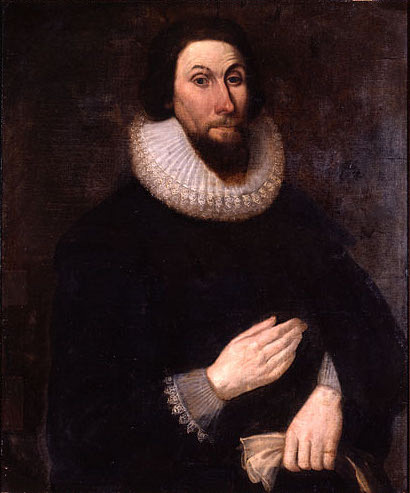
King Philip's War (1675-1678) was a three-year conflict of attrition during which King Philip struck at the colonists through guerilla tactics, sparing no one, and the colonists assembled militias to attack native encampments. Hostilities continued until King Philip was betrayed and killed by one of his own men. By the end of the war, thousands were dead on both sides and the natives were driven off their land. Many were sold into slavery, and others forced onto reservations. The Plymouth colony, which naturally sided with the other colonists of the region, lost a significant number of citizens and afterwards severed ties with the Native American communities that remained.
Conclusion
The Massachusetts Bay Company claimed large tracts of land comprising most of the states of present-day New England, and in 1691, the Plymouth colony was absorbed into it. Bradford's account of the colony's founding and first years, written between 1630-1651 was republished as Of Plymouth Plantation in 1856. The popularity of the book (considered an American classic in the present day) encouraged the already high level of interest in the pilgrims of Plymouth, which had been ongoing since before the American War of Independence (1775-1783) and played a part in the establishment of Thanksgiving Day.
Bradford's work was the literary accompaniment to the physical symbol of the pilgrim's arrival – Plymouth Rock – which was identified in 1741 as the landing site of the Mayflower in 1620 by one Thomas Faunce (then 90 years old) whose father had arrived in the colony in 1623. Although there is no mention in Bradford's work - or any other early accounts of the colony - of the rock, the Bradford narrative has come to inform it. In the present day, Plymouth Rock has come to symbolize the values of courage, faith, determination, and strength embodied by the pilgrims of 1620 as well as the foundational moment of their arrival in the New World, which they would forever change.
